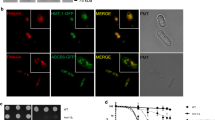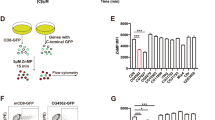Abstract
Copper is an integral part of a number of proteins and thus an essential trace metal. However, free copper ions can be highly toxic and every organism has to carefully control its bioavailability. Eukaryotes contain three copper chaperones; Atx1p/Atox1 which delivers copper to ATP7 transporters located in the trans-Golgi network, Cox17 which provides copper to the mitochondrial cytochrome c oxidase, and CCS which is a copper chaperone for superoxide dismutase 1. Here we describe the knockout phenotype of the Drosophila homolog of mammalian Atox1 (ATX1 in yeast). Atox1−/− flies develop normally, though at reduced numbers, and the eclosing flies are fertile. However, the mutants are unable to develop on low-copper food. Furthermore, the intestinal copper importer Ctr1B, which is regulated by copper demand, fails to be induced upon copper starvation in Atox1−/− larvae. At the same time, intestinal metallothionein is upregulated. This phenotype, which resembles the one of the ATP7 mutant, is best explained by intestinal copper accumulation, combined with insufficient delivery to the rest of the body. In addition, compared to controls, Drosophila Atox1 mutants are relatively insensitive to the anticancer drug cisplatin, a compound which is also imported via Ctr1 copper transporters and was recently found to bind mammalian Atox1.





Similar content being viewed by others
References
Arnesano F, Banci L, Bertini I, Cantini F, Ciofi-Baffoni S, Huffman DL, O’Halloran TV (2001) Characterization of the binding interface between the copper chaperone Atx1 and the first cytosolic domain of Ccc2 ATPase. J Biol Chem 276:41365–41376
Balamurugan K, Schaffner W (2006) Copper homeostasis in eukaryotes: teetering on a tightrope. Biochim Biophys Acta 1763:737–746
Balamurugan K, Egli D, Hua H, Rajaram R, Seisenbacher G, Georgiev O, Schaffner W (2007) Copper homeostasis in Drosophila by complex interplay of import, storage and behavioral avoidance. EMBO J 26:1035–1044
Bayer TA, Schafer S, Simons A, Kemmling A, Kamer T, Tepest R, Eckert A, Schussel K, Eikenberg O, Sturchler-Pierrat C, Abramowski D, Staufenbiel M, Multhaup G (2003) Dietary Cu stabilizes brain superoxide dismutase 1 activity and reduces amyloid Abeta production in APP23 transgenic mice. Proc Natl Acad Sci 100:14187–14192
Bischof J, Maeda RK, Hediger M, Karch F, Basler K (2007) An optimized transgenesis system for Drosophila using germ-line-specific phiC31 integrases. Proc Natl Acad Sci 104:3312–3317
Boal AK, Rosenzweig AC (2009) Crystal structures of cisplatin bound to a human copper chaperone. J Am Chem Soc 131:14196–14197
Burke R, Commons E, Camakaris J (2008) Expression and localisation of the essential copper transporter DmATP7 in Drosophila neuronal and intestinal tissues. Int J Biochem Cell Biol 40:1850–1860
Camakaris J, Voskoboinik I, Mercer JF (1999) Molecular mechanisms of copper homeostasis. Biochem Biophys Res Commun 261:225–232
Cepeda V, Fuertes MA, Castilla J, Alonso C, Quevedo C, Perez JM (2007) Biochemical mechanisms of cisplatin cytotoxicity. Anticancer Agents Med Chem 7:3–18
Cobine P, Wickramasinghe WA, Harrison MD, Weber T, Solioz M, Dameron CT (1999) The Enterococcus hirae copper chaperone CopZ delivers copper(I) to the CopY repressor. FEBS Lett 445:27–30
Cottrell DA, Blakely EL, Johnson MA, Ince PG, Turnbull DM (2001) Mitochondrial enzyme-deficient hippocampal neurons and choroidal cells in AD. Neurology 57:260–264
Culotta VC, Yang M, O’Halloran TV (2006) Activation of superoxide dismutases: putting the metal to the pedal. Biochim Biophys Acta 1763:747–758
De Feo CJ, Aller SG, Siluvai GS, Blackburn NJ, Unger VM (2009) Three-dimensional structure of the human copper transporter hCTR1. Proc Natl Acad Sci 106:4237–4242
Egli D, Yepiskoposyan H, Selvaraj A, Balamurugan K, Rajaram R, Simons A, Multhaup G, Mettler S, Vardanyan A, Georgiev O, Schaffner W (2006) A family knockout of all four Drosophila metallothioneins reveals a central role in copper homeostasis and detoxification. Mol Cell Biol 26:2286–2296
Gupta A, Lutsenko S (2009) Human copper transporters: mechanism, role in human diseases and therapeutic potential. Future Med Chem 1:1125–1142
Hamza I, Faisst A, Prohaska J, Chen J, Gruss P, Gitlin JD (2001) The metallochaperone Atox1 plays a critical role in perinatal copper homeostasis. Proc Natl Acad Sci 98:6848–6852
Hamza I, Prohaska J, Gitlin JD (2003) Essential role for Atox1 in the copper-mediated intracellular trafficking of the Menkes ATPase. Proc Natl Acad Sci 100:1215–1220
Holzer AK, Katano K, Klomp LW, Howell SB (2004) Cisplatin rapidly down-regulates its own influx transporter hCTR1 in cultured human ovarian carcinoma cells. Clin Cancer Res 10:6744–6749
Horng YC, Cobine PA, Maxfield AB, Carr HS, Winge DR (2004) Specific copper transfer from the Cox17 metallochaperone to both Sco1 and Cox11 in the assembly of yeast cytochrome c oxidase. J Biol Chem 279:35334–35340
Ishida S, Lee J, Thiele DJ, Herskowitz I (2002) Uptake of the anticancer drug cisplatin mediated by the copper transporter Ctr1 in yeast and mammals. Proc Natl Acad Sci 99:14298–14302
Kennerson ML, Nicholson GA, Kaler SG, Kowalski B, Mercer JF, Tang J, Llanos RM, Chu S, Takata RI, Speck-Martins CE, Baets J, Almeida-Souza L, Fischer D, Timmerman V, Taylor PE, Scherer SS, Ferguson TA, Bird TD, De Jonghe P, Feely SM, Shy ME, Garbern JY (2010) Missense mutations in the copper transporter gene ATP7A cause X-linked distal hereditary motor neuropathy. Am J Hum Genet 86:343–352
Kim BE, Nevitt T, Thiele DJ (2008) Mechanisms for copper acquisition, distribution and regulation. Nat Chem Biol 4:176–185
Lee J, Pena MM, Nose Y, Thiele DJ (2002) Biochemical characterization of the human copper transporter Ctr1. J Biol Chem 277:4380–4387
Lin X, Okuda T, Holzer A, Howell SB (2002) The copper transporter CTR1 regulates cisplatin uptake in Saccharomyces cerevisiae. Mol Pharmacol 62:1154–1159
Markossian KA, Kurganov BI (2003) Copper chaperones, intracellular copper trafficking proteins. Function, structure, and mechanism of action. Biochemistry 68:827–837
Maurer I, Zierz S, Moller HJ (2000) A selective defect of cytochrome c oxidase is present in brain of Alzheimer disease patients. Neurobiol Aging 21:455–462
Mercer JF (2001) The molecular basis of copper-transport diseases. Trends Mol Med 7:64–69
Mercer JF, Llanos RM (2003) Molecular and cellular aspects of copper transport in developing mammals. J Nutr 133:1481S–1484S
Norgate M, Lee E, Southon A, Farlow A, Batterham P, Camakaris J, Burke R (2006) Essential roles in development and pigmentation for the Drosophila copper transporter DmATP7. Mol Biol Cell 17:475–484
O’Halloran TV, Culotta VC (2000) Metallochaperones, an intracellular shuttle service for metal ions. J Biol Chem 275:25057–25060
Petris MJ (2004) The SLC31 (Ctr) copper transporter family. Pflugers Arch 447:752–755
Prohaska JR, Gybina AA (2004) Intracellular copper transport in mammals. J Nutr 134:1003–1006
Puig S, Thiele DJ (2002) Molecular mechanisms of copper uptake and distribution. Curr Opin Chem Biol 6:171–180
Safaei R, Maktabi MH, Blair BG, Larson CA, Howell SB (2009) Effects of the loss of Atox1 on the cellular pharmacology of cisplatin. J Inorg Biochem 103:333–341
Schmidt PJ, Kunst C, Culotta VC (2000) Copper activation of superoxide dismutase 1 (SOD1) in vivo. Role for protein-protein interactions with the copper chaperone for SOD1. J Biol Chem 275:33771–33776
Selvaraj A, Balamurugan K, Yepiskoposyan H, Zhou H, Egli D, Georgiev O, Thiele DJ, Schaffner W (2005) Metal-responsive transcription factor (MTF-1) handles both extremes, copper load and copper starvation, by activating different genes. Genes Dev 19:891–896
Sinani D, Adle DJ, Kim H, Lee J (2007) Distinct mechanisms for Ctr1-mediated copper and cisplatin transport. J Biol Chem 282:26775–26785
Southon A, Burke R, Norgate M, Batterham P, Camakaris J (2004) Copper homoeostasis in Drosophila melanogaster S2 cells. Biochem J 383:303–309
Srinivasan C, Posewitz MC, George GN, Winge DR (1998) Characterization of the copper chaperone Cox17 of Saccharomyces cerevisiae. Biochemistry 37:7572–7577
Steiger D, Fetchko M, Vardanyan A, Atanesyan L, Steiner K, Turski ML, Thiele DJ, Georgiev O, Schaffner W (2010) The Drosophila copper transporter Ctr1C functions in male fertility. J Biol Chem 285:17089–17097
Tumer Z, Moller LB, Horn N (1999) Mutation spectrum of ATP7A, the gene defective in Menkes disease. Adv Exp Med Biol 448:83–95
Turski ML, Thiele DJ (2007) Drosophila Ctr1A functions as a copper transporter essential for development. J Biol Chem 282:24017–24026
Walker JM, Tsivkovskii R, Lutsenko S (2002) Metallochaperone Atox1 transfers copper to the NH2-terminal domain of the Wilson’s disease protein and regulates its catalytic activity. J Biol Chem 277:27953–27959
Weaver RF, Weissmann C (1979) Mapping of RNA by a modification of the Berk-Sharp procedure: the 5′ termini of 15 S beta-globin mRNA precursor and mature 10S beta-globin mRNA have identical map coordinates. Nucleic Acids Res 7:1175–1193
Wong PC, Waggoner D, Subramaniam JR, Tessarollo L, Bartnikas TB, Culotta VC, Price DL, Rothstein J, Gitlin JD (2000) Copper chaperone for superoxide dismutase is essential to activate mammalian Cu/Zn superoxide dismutase. Proc Natl Acad Sci 97:2886–2891
Zhou H, Cadigan KM, Thiele DJ (2003) A copper-regulated transporter required for copper acquisition, pigmentation, and specific stages of development in Drosophila melanogaster. J Biol Chem 278:48210–48218
Acknowledgments
We thank Drs. Johannes Bischof and Konrad Basler (University of Zürich) for the Phi C31 integration system, attP fly lines and the flies carrying transposase (y w; + ; ∆2-3 Sb/TM2). We are also grateful to Till Strassen for the maintenance of fly stocks, to Dr. Dominik Steiger for valuable discussions and to Drs. George Hausmann (University of Zürich) and Dennis J. Thiele (Duke University, NC) for critical reading of the manuscript. This work was supported by the Kanton Zürich and by the Swiss National Science Foundation.
Author information
Authors and Affiliations
Corresponding author
Additional information
Haiqing Hua and Viola Günther contributed equally to this work.
Rights and permissions
About this article
Cite this article
Hua, H., Günther, V., Georgiev, O. et al. Distorted copper homeostasis with decreased sensitivity to cisplatin upon chaperone Atox1 deletion in Drosophila . Biometals 24, 445–453 (2011). https://doi.org/10.1007/s10534-011-9438-1
Received:
Accepted:
Published:
Issue Date:
DOI: https://doi.org/10.1007/s10534-011-9438-1




